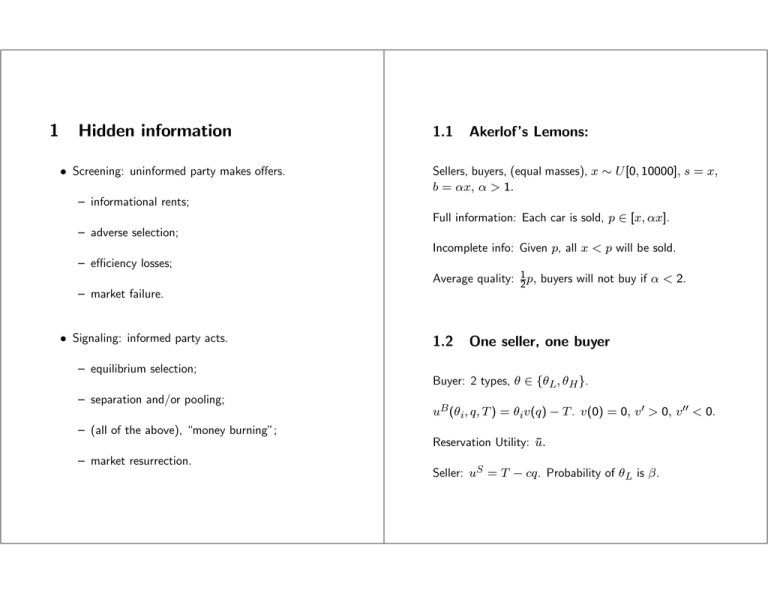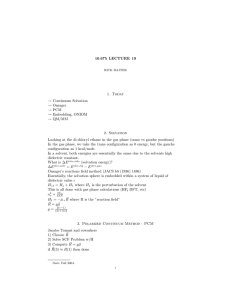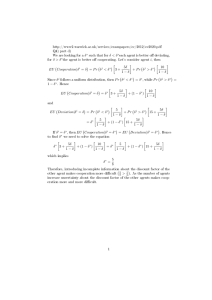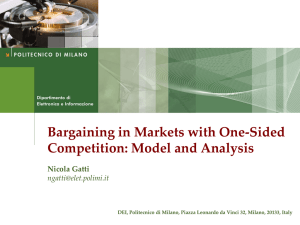1 Hidden information 1.1 Akerlof’s Lemons:
advertisement

1
Hidden information
• Screening: uninformed party makes offers.
1.1
Akerlof’s Lemons:
Sellers, buyers, (equal masses), x ∼ U [0, 10000], s = x,
b = αx, α > 1.
— informational rents;
— adverse selection;
Full information: Each car is sold, p ∈ [x, αx].
Incomplete info: Given p, all x < p will be sold.
— efficiency losses;
— market failure.
• Signaling: informed party acts.
Average quality: 12 p, buyers will not buy if α < 2.
1.2
One seller, one buyer
— equilibrium selection;
— separation and/or pooling;
— (all of the above), “money burning”;
Buyer: 2 types, θ ∈ {θL, θH }.
uB (θi, q, T ) = θiv(q) − T . v(0) = 0, v 0 > 0, v 00 < 0.
Reservation Utility: ū.
— market resurrection.
Seller: uS = T − cq. Probability of θL is β.
• Complete info:
• Single two-part tariff: (Z, P ), where Z is fixed fee.
Seller: Ti − cqi →Ti,qi max, s.t. θiv(qi) − Ti ≥ ū.
Can extract all surplus from type L, Z ≥ SL(P ).
Solution: uB = ū, θiv 0(qi) = c.
If serving H market only: P = c, Z = SH (P ).
Implementation: two-part tariff, a bundle, ...
If two: SL(P ) + (P − c)D(P ) →P max.
• Incomplete info: Linear price:
Each buyer: θiv(q) − P q → max, θiv0(qi) = P .
Seller: (Monopoly) (P − c)D(P ) →P max.
D(P )
Pm = c − D0(P ) .
Note: If both types are served, both have positive surplus.
P =c−
0 (P )
D(P )+SL
D(P )−DL(P )
=c−
.
D0 (P )
D0 (P )
1.3
Optimal scheme
Obs1: only two contracts (Ti, qi) (by revelation principle), 4 constraints: 2IC and 2IR.
Obs 2: IRH not binding.
Obs 3: IRL not binding. (consider full information optimum).
1.4
Credit rationing
Invest 1, Return R with prob P .
Borrowers: i = s, r.
• A1: piRi = m > 1,
A2: ps > pr , Rs < Rr .
(ū = 0) TL = θLv(qL), TH = θH v(qH ) − θH v(qL) +
TL.
Seller’s problem:
maxqL,qH β [θLv(qL) − cqL] +
+ (1 − β) [θH v(qH ) − θH v(qL) + θLv(qL) − cqH ].
FOC (qH ): θH v 0(qH ) = c – efficiency on top, SH > 0.
FOC (qL): θLv 0(qL) > c – under provision, SL = 0.
Lender: Has 1 > α > max{β, 1 − β} to lend.
• Complete info: repay Di = Ri.
• Incomplete info: (D as an instrument)
D = Rr (one type is served) or D = Rs (credit
rationing).?
• Random contract: (xi, Di), xi is probability of financing.
1.5
Multiple types: Finite N
IRS and ICR are binding.
θn > θn−1 > . . . > θ1, n > 2.
xr = 1, xs < 1. No rationing. Safe borrowers are
indifferent.
uB (θi, q, T ) = θiv(q) − T
A3: psRs > 1, pr Rr < 1.
Either both (cross-subsidy) or none are financed.
• Seller: β i = Pr(θi).
⎧ P
n β (T − cq ) →
⎪
⎨
i
Ti,qi max, s.t.
i=1 i i
IR : ∀i, θiv(qi) − Ti ≥ 0,
⎪
⎩ IC : ∀i, j θ v(q ) − T ≥ θ v(q ) − T .
i
i
i
i
j
j
• IR: binding only for θ1.
∙
¸
∂u/∂q
∂
• Spence-Mirlees single-crossing: ∂θ − ∂u/∂T > 0.
• IC: (1) Only local C matter;
³
ICij & ICji ⇒ θi − θj
´h
i
v(qi) − v(qj ) ≥ 0 ⇒ qi > qj .
θiv(qi) − Ti ≥ θiv(qi−1) − Ti−1 ⇒ θi+1v(qi) − Ti ≥
θi+1v(qi−1) − Ti−1;
θi+1v(qi+1)−Ti+1 ≥ θi+1v(qi)−Ti ≥ θi+1v(qi−1)−
Ti−1.
• (2) Only Downstream C matter. All local DC bind.
Ignore upstream. If one local DC is loose, increase all
upstream T .
• Solution: mimics two types.
Express Ti, plug into objective function.
• Results: Efficiency on top, no surplus on the bottom.
1.6
Multiple types: Continuous support
• Seller: θ ∼ F [0, θ̄].
⎧
R θ̄
⎪
⎪
⎨ 0 [Tθ − cqθ ] f (θ) dθ →Tθ ,qθ max, s.t.
IR : ∀θ, θv(qθ ) − Tθ ≥ 0,
⎪
⎪
⎩ IC : ∀θ, θ 0 θv(q ) − T ≥ θv(q 0 ) − T 0 .
θ
θ
θ
θ
• IR: only for θ = 0 matters.
n
• IC: W (θ) ≡ θv(qθ ) − Tθ = maxθ0 θv(qθ0 ) − Tθ0
• Thus,
dW (θ)
∂W (θ)
dθ = ∂θ = v(qθ ),
R
R
W (θ) = 0θ v(qx)dx + W (0) = 0θ v(qx)dx.
Tθ = θv(qθ ) − W (θ).
o
h
i
R
R
• π = 0θ̄ θv(qθ ) − 0θ v(qx)dx − cqθ f (θ)dθ.
R
• π = 0θ̄ L(qθ , Tθ )f (θ)dθ → maxq,T
1−F (θ)
• L = θv(qθ ) − cqθ − f (θ) v(qθ ).
2
Spence’s Model
Worker’s productivity: rH > rL > 0.
Firm’s prior: β i = Pr{r = ri}.
Education: ci(e) = θie, θH < θL.
• Thus, ∂L
∂q = 0,
"
#
1 − F (θ) 0
θ−
v (qθ ) = c.
f (θ)
• Results: Underconsumption for all θ < θ̄.
• p(qθ ) ≡ Tθ0 = θv 0(qθ ),
1−F (θ)
p−c
p = θf (θ) .
dq
≥ 0.
• Do not forget: dθ
• Complete info: eL = eH = 0, wi = ri.
• Incomplete info:
σ i – mixed strategy of i over e.
β(ri|e) – firm’s posterior belief.
w(e) = β(rL|e)rL + β(rH |e)rH
• Solution: Perfect Bayesian Equilibrium
PBE: {σ H , σ L, (β(ri|e))e∈E } , such that, for all i,
1. ∀e∗ ∈ Supp σ i, e∗ ∈ arg maxe [w(e) − θie] .
β Pr(σ i=e)
whenever possible, oth2. β(ri|e) = P iβ Pr(σ
j =e)
j j
erwise not restricted.
3. w(e) = β(rL|e)rL + β(rH |e)rH .
• Beliefs are restricted on-equilibrium path only.
• Three types of equilibria:
1. Separating eqm: e∗H 6= e∗L.
2. Pooling eqm: e∗H = e∗L.
3. Semiseparating (mixed) eqm.
2.1
Analysis
• Separating equilibria:
SS =
(
e∗L = 0;
e∗H ∈
"
rH − rL rH − rL
,
θL
θH
#)
.
Beliefs: β(rH |e) = 1 ⇔ e ≥ e∗H . β(rH |e) = 0, otherwise.
• Pooling equilibria:
(
"
β r + β H rH − rL
S P = e∗L = e∗H ∈ 0, L L
θL
#)
.
Beliefs: β(rH |e) = β H ⇔ e ≥ e∗H . β(rH |e) = 0,
otherwise.
2.2
Refinements
Cho and Kreps’ Intuitive criterion.
Suppose a deviator automatically reveals his type, will he
still be willing to deviate?
Denote u∗i = wi(e∗i ) − θiei. Consider e 6= e∗H , e∗L.
If rL −θLe < u∗L and rH −θH e > u∗H , then β(rH |e) =
1. (the other case similarly).
• Unique eqm: Least-Cost Separating eqm.
• Plausibility? β L → 0.
2.3
Maskin & Tirole Problem
Contract is offered before the signal is chosen: {w(e)}.
• Case 1 : Er ≤ rH − θθH (rH − rL).
L
Unique eqm: w(e) as in Least-Cost eqm.
• Case 2 : Er ≥ rH − θθH (rH − rL). L-C can be
L
improved.
2.4
Issues
• Competition:
Auction for Lemon’s: Can it work?
• Market design, regulation:
3
Hidden Action
• Pay before the service or after?
— Before: Lousy Service.
— After: Why pay?
• Sign a contract: Pay before or after?
3.1
Simple model
• Agent: u(w) − ψ(a) →a max,
u0 > 0, u00 ≤ 0, ψ 0 > 0, ψ 00 ≥ 0. ψ(a) = a.
• Principal: V (q − w(q)) →w(q·),OB max
• (Not)Observable: Effort, Output, Noisy signal.
• Moral hazard: Nobody’s watching.
Technology: q ∈ {0, 1}, P r(q = 1|a) = p(a)
• References: B & D.
p0 > 0, p00 < 0, p(0) = 0, p(∞) = 1, p0(0) > 1.
• (**) pay attention.
3.1.1
Everything observable (q, a)
P P = p(a)V (1−w1)+(1−p(a))V (−w0) →a,w0,w1 max
s.t. AG = p(a)u(w1) + (1 − p(a))u(w0) − a ≥ ū.
Solution: L = P P + λAG → max.
FOC:(w0): −(1−p(a))V 0(−w0)+λ(1−p(a))u0(wo) = 0
add (w1): Borch rule (**)
V 0(−w0)
V 0(1 − w1)
=
=λ
u0(w1)
u0(w0)
FOC: (a): p0(a)(V (1 − w1) − V (−w0))
+λ(p0(a)(u(w1) − u(w0)) − 1) = 0
1 .
• Ex 1:(**) V (x) = x. u(w∗) = a∗, p0(a∗) = u0(w
∗)
3.1.2
Only q is observable
Agent: AG = p(a)u(w1)+(1−p(a))u(w0)−a →a max.
Principal: P P (a, w0, w1) →w0,w1 max .
s.t. AG(a∗) ≥ ū, a∗ ∈ arg maxa AG(a).
FOC (AG): p0(a)(u(w1) − u(w0)) = 0.
• Ex 3. V (x) = x, u(x) = x, but x ≥ 0.
— First best: Sale of firm at price −w0∗.
If w0∗ = 0, w1∗ = 1, AG(a) = p(a∗) − a∗ > 0.
P P = 0.
— Second-best: (**) Agent: p0(a)w1 = 1.
• Ex 2:(**) u(x) = x. w1∗ − w0∗ = 1, p0(a∗) = 1.
Principal: p(a)(1 − w1) →w1 max, s.t. above.
Solution â < a∗.
• general case: (**)
Continuous setting
V 0(1 − w1)
p0(a)
=
λ
+
µ
u0(w1)
p(a)
• Principal V (q − w). Agent: u(w) − ψ(a).
V 0(−w0)
p0(a)
=
λ
−
µ
u0(w0)
1 − p(a)
• Suppose q ∈ [q0, q 1]. F (q|a)-cdf, f (q|a)-pdf.
For µ = 0, Borch rule. But, often µ > 0, so:
(**) reward for q = 1, punishment for q = 0.
Effort is known, reward-punishment create incentives.
3.2
3.3
Value of Information(?)
Observe, q, s, s ∈ {0, 1}, P r(q = i, s = j|a) = pij (a).
p0ij (a)
V 0(i − wij )
=λ+µ
u0(wij )
pij (a)
When s goes away? When q is sufficient statistic) for a?
R 1
P P (a, w(q)) = qq0 V (q−w(q))f (q|a)dq →a,w(q) max.
R 1
s.t.AG(a, w(q)) = qq0 u(w(q))f (q|a)dq − ψ(a) ≥ ū
• If a unobservable, a∗ ∈ arg maxa AG(a, w(q)).
R
1
FOC: (a): qq0 u(w(q))fa(q|a)dq = ψ 0(a).
Obtain: (**)
L=
Z
⎡
⎣
h(w(µ
q), a) + λ(u(w(q) − ψ(a¶))+
f (q|a)
µ u(w(q)) fa(q|a) − ψ 0(a)
⎤
⎦ f (q|a)dq
3.4
Solution
V 0(q − w(q))
fa(q|a)
=
.
λ
+
µ
u0(w(q))
f (q|a)
On supports and distributions
• Principal and agent are risk-neutral:
If for all a, F (q|a) are linearly independent (finite
number of output levels), first-best is obtainable: a
la Cremer & McLean. (same critique)
• Two problems:
— FOC: (a): (**) is necessary (internal!) not sufficient (!).
f (q|a)
— (**) fa(q|a) determine which qs are rewarded
(punished)
• Ex 4. Suppose a∗ = a1 > a0 (only two values of
a).
"
V 0(q − w(q))
f (q|a0)
=
1
−
λ
+
µ
u0(w(q))
f (q|a1)
#
f (q|a0)
> 1 (< 1) determines q is punished (rewarded).
f (q|a1)
• Suppose q = a + ε, ε ∈ [−x, x]. Again, first-best is
achievable (risk-aversion is fine, no limited liability),
with severe penalties for q < a∗ − x.
Same might be true (in approx) even if ε is unbounded, and agent is risk-averse.
• HYP: Subcase (extends for finite a’s: aL = 0; aH =
f (q|a )
1. If q 0 exists such that f (q|aH) → 0 when q → q 0
L
first-best can be approximated
3.5
Grossman & Hart approach
• a unobservable: V →w(q) max, s.t U (w, a) ≥ ū,
Finite # of q’s: 0 ≤ q1 < q2 < · · · < qn.
(IC) U (w, a) = maxâ∈A U(w, â).
pi(a) = Pr(q = qi|a)
To solve: two-step program:
V =q−w
1. Find how to implement given a in the least-costly way,
optimize over i.
U (w, a) = φ(a)u(w(q)) − ψ(a),
u with usual properties, and limw→wo+u(w) = −∞.
• a observable:
V =
Pn
i=1 pi(a)(qi − wi) →a,w(q) max
s.t. U (w, a) ≥ ū.
Full insurance, thus w = u−1
then V =
P
µ
ū+ψ(a)
φ(a)
pi(a)qi − w →a max.
¶
2. Optimize minimal costs over a.
• Trick, write down the whole problem as a convex
problem (so SOC automatically satisfied). Instead
of searching over wi, search over ui = u(wi).
Let U = Im u(w0, ∞). Assume:
Define wi = h(ui) = u−1u(wi).
ū+ψ(a)
∈ U.
φ(a)
Thus, the program: *given a.
minu1,...,un
Pn
i=1 pi(a)h(ui)
s.t.
⎧
⎪
⎨
Pn
i=1 pi(a)(φ(a)ui − ψ(a)) ≥ ū,
P
n p (a)(φ(a)u − ψ(a)) ≥
i
i=1 i
P
⎪
⎩
n p (â)(φ(â)u − ψ(â)), for all â ∈ A
i
i=1 i
Note: Linear constraints, convex objective.
nP
o
n
Define C(a) = inf
i=1 pi(a)h(ui)|u implements a .
If, no u exists, define C(a) = ∞.
It is important that pi(a) > 0 for all i and a. If C(a) <
∞, then each wi less ∞.
Step 2. maxa∈A
nP
o
n p (a)q − C(a) .
i
i=1 i



